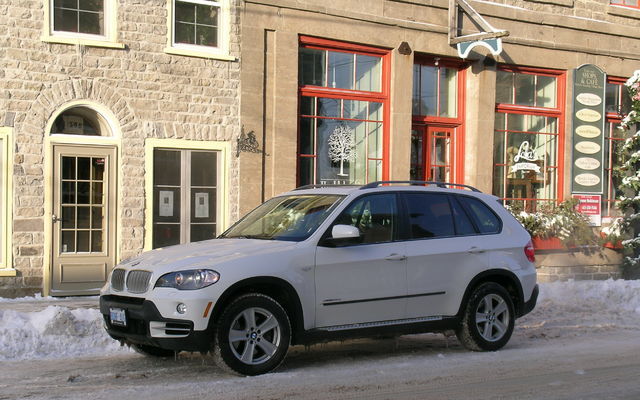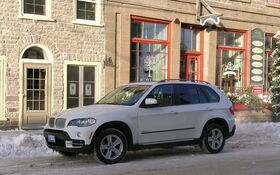BMW X5 xDrive35d: Luxuriously Sparkplugless

| Strong points |
|
|---|---|
| Weak points |
|
Perhaps it’s fitting that the next evolution of BMW’s first SUV comes on the cusp of the nameplates 10th anniversary. Melding BMW’s handsome design language with the relatively massive proportions of a seven-seater SUV, the 1999 BMW X5 was the bizarre result of an extensive development program than included the acquisition of Land Rover. Using the contemporary Range Rover as a sort of test bed of sorts, BMW’s engineers lifted technology from the off-road legend while borrowing extensively from the 5-series platform; hence the X5 moniker. The result was something altogether different.
One of the first premium SUVs (or, as BMW calls it, an “SAV,” as in Sports Activity Vehicle) to place a greater importance on roadgoing performance over off-road ability, the first generation X5 won many critics over with its 5-series inspired antics, amazing handling, and handsome styling. Fully equipped, the biggest BMW sported aggressive flares, massively wide tires, and a 4.8L, 350 horsepower V8.
- Also: 2009 BMW 335d and X5 35d: Is diesel the logical choice?
- Also: 2014 BMW X5 eDrive Plug-in Hybrid
In 2007, the X5 was completely revised to better fit with the new era of Chris Bangle designed BMWs. Still based upon the equally new 5-series, the E70 X5 carried over many of the previous X5’s best loved traits, coming into the world longer and wider than the outgoing model. Once again, the top spec trim packages boasted plenty of aggression outside, and a fire breathing 4.8L V8 under hood. But in the age of gas station receipts that would put a visit to the local steakhouse to shame, the gigantic V8 was a far cry from the attractive option it once was.
So what could one do, if one required the power and torque of the big V8, but wanted the thriftiness of the inline six powerplant? In a word; nothing.
Until this year.
Finally breaking ground after a long and torturous development program, we North Americans can finally enjoy amazing performance and economy of BMW’s diesel powerplant. Offered overseas for years, the Bluetec-developed 3.0L inline six won an award as one of Ward’s 10 Best Engines just month’s after its debut. Called the BMW Advanced Diesel with BluePerformance, the 3.0L motor boasts an aluminum crankcase and direct injection from its common rail-type fuel system that contains fuel pressurized to 26,000 psi. Two turbochargers, mounted sequentially, keep turbo lag at a minimum while providing effortless power throughout the rev range, and endow the mid-size vehicle with 265 horsepower and a breathtaking 425 foot pounds of torque. Compared to the burly 4.8L V8, the diesel engine reaches its peak torque at just 1,750 rpm, as opposed to the relatively stratospheric 3,400 rpm of the gasoline motor; the result of the diesel’s compression ratio of 16.5:1, a full 63% higher than the gasoline engine.
Of course, being one of the offspring of the Bluetec engine development program of a few years ago, the diesel’s exhaust is treated with an injected urea solution to lower NOX emissions. After being injected into the exhaust, the urea solution creates ammonia that then converts the nitric oxides (NOX) in the exhaust into environmentally friendly nitrogen and water vapour. Like similar systems, the urea supply must be refilled occasionally, however, by equipping the X5d with 23.1 litres of urea capacity in a pair of tanks (one of which is heated to ensure a fluid urea solution in temperatures below -11 c), BMW has managed to fit the urea refilling periods within the standard scheduled maintenance stops, and will cover the cost of the refills and solution for the first for years or 50,000 miles.
All that being said, one never considers any of that when piloting the X5 xDrive35d down the road. As with all second-generation X5’s, the diesel variant breaks with 45 years of MacPherson strut tradition out front; implementing a double wishbone multi-link design with upper A-arms combined with double-pivot lower links. Combined with the four link rear suspension, the X5’s ride is firm, and even equipped with winter tires, roadholding was surprisingly good. Railing through corners with aplomb, the higher center of gravity does create some body roll, but far less than you’d expect of a vehicle of this scale.
However, when getting aggressive with the throttle, one must keep in mind the unique power output of the diesel drivetrain. So quiet and smooth that it’s easily mistaken for a gasoline powerplant, coming out of a corner with such grip as the X5 generated entices the driver to introduce the skinny pedal to the carpet, and the resulting instantaneous 425 foot pounds of torque easily overwhelm the rear tires. A quick flicker of the traction control/DSC light on the dashboard along with the bizarre sensation of additional power being shuttled to the front differential is as dramatic as the X5 gets before all that torque hurls the 5,225 pound “SAV” down the next straight.
Of course, as is often the case in a Canadian January, that next straight (or corner for that matter) may not be completely clear of snow and ice. As tested, our X5 xDrive35d was equipped with snow tires to better glean traction from the subzero road surface, and taking one long, meandering route from Vancouver to Kelowna, the combination of the diesel’s abundance of torque and slow engine speed worked in concert with the excellent DSC system, winter tires, and all-wheel drive layout to propel the X5 through some relatively aggressive snow drifts. Even a trip off the beaten path up to a completely unplowed plateau didn’t deter the Bavarian machine. Accompanied at the time by an equally new Volvo XC90 V8 that was also shod in winter tires and piloted by a journalist cohort, the X5 ran circles around the Swedish creation. As the Haldex system in the Volvo strained itself to keep the big Volvo moving, the more dynamic BMW xDrive system had no trouble. Using a collection of clutch packs to provide torque to either axle, the BMW system has a static distribution of 60% rear, 40% front, with the capacity to send full power to either end. With the DSC on, traction was maximized, and the lack of wheelspin got the BMW up on top of the snow pack with ease, and only a couple severe hills required more than one attempt to summit. Conversely, with the DSC off, the diesel’s low-range torque and excellent six-speed automatic transmission kept the wheels spinning for some flatland hooliganry.
But regardless of the conditions underfoot, the X5 never put a wheel wrong. Be it upon dry pavement or a foot of fresh snow under the skidplates, the combination of the excellent platform and impressive engine provides a completely unflustered driving experience. Coddled by the same superlative power adjustable seats with adjustable thigh, lumbar, and bolster supports, and with the same excellent driving position, the X5 does an excellent rendition of the 5-series’ driving experience, albeit with a whole lot more vehicle involved therein. In the second row, an impressive amount of legroom ensures comfort while large, expansive windows keep the onset of claustrophobia for the third row denizens at bay.
Starting at just $62,200, the X5 xDrive 35d may be one of the best deals in the premium SUV marketplace. Providing V8 power without the unpleasant fuel bills, an exuberant four hour road trip up one of BC’s most infamous mountain highways rewarded with a $25 dollar fill up. And with the price of diesel coming down even as the price of gas rises once again, the 10.9 litres averaged for even hundred kilometres traversed makes this one attractive alternative to its gasoline-powered competitors. Giving up nearly nothing in terms of capability and performance, the diesel engine is as refined as any modern gasoline engine, and the interior is every bit as luxurious as you’d expect. Opening up an entirely new market, the xDrive35d is definitely a fantastic way to usher in another ten years of BMW’s sports activity vehicle.











